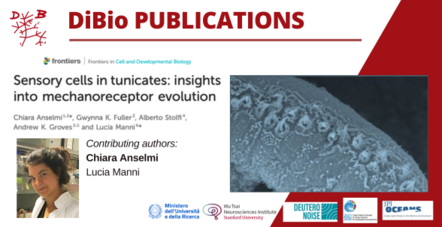
Sensory cells in tunicates: insights into mechanoreceptor evolution
Pubblicato il: 08.04.2024 20:37
Anselmi C., Fuller G.K., Stolfi A., Groves A.K., Manni L. 2024. Sensory cells in tunicates: insights into mechanoreceptor evolution. Front Cell Dev Biol (In Research Collection “Tunicates in Evolutionary Developmental Biology”). Front Cell Dev Biol 2:1359207. doi: 10.3389/fcell.2024.1359207
In the context of a Research Collection devoted to the “Tunicates in Evolutionary Developmental Biology”, published by Frontiers in Cell and Developmental Biology, Chiara Anselmi and Lucia Manni, together with Gwynna K. Fuller and Antony K. from the Baylor College of Medicine, Houston, USA, and with Alberto Stolfi, from the Georgia Institute of Technology, Atlanta, USA, published the review titled “Sensory cells in tunicates: insights into mechanoreceptor evolution”. The publication covers anatomical, cellular and molecular levels highlighting both similarity and differences between tunicate and vertebrate mechanoreceptor strategies. Indeed, Tunicates, the sister group of vertebrates, although very limited in mobility requirements at both larval and adult stages, display a variety of mechanoreceptor structures. Among them, the coronal sensory cells are prime candidate as homologous to the vertebrate hair cells of the inner ear and the lateral line organ of vertebrates. Therefore, their study allow understanding the evolution of the sensory cells involved in hearing, balance, and environment perception. While further research is needed to unravel the molecular and developmental features of these tunicate sensory cells, their study has significantly contributed to illuminate the complex pathways shaping the vertebrate sensory system.





